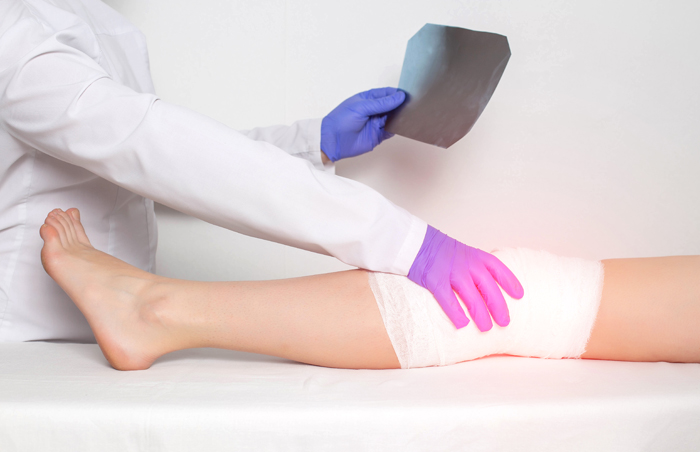Ligament Tear Treatment in Sadashiv Peth, Pune
Ligaments are strong, flexible tissue bands that link bones all across the body. They provide mobility between bones, allowing one to flex their foot or move their fingers. If stretched beyond their natural capacity, ligaments can tear.
What are Ligament Tears?
When a joint is subjected to a great deal of force, such as during a high-impact incident or a fall, a ligament tear can occur. Usually, ligament tears occur in the knees, neck, thumbs, ankles, wrists, and back.

What Are the Symptoms of Ligament Tears?
Symptoms of ligament tears include –
- Tenderness
- Pain
- Bruising
- Swelling
- Stiffness
- Difficulty moving the joint
- A snap or tearing sensation at the time of the injury
- Muscle spasms
- Joint becoming loose
- Impaired movement
What Are the Causes of Ligament Tears?
A ligament tear can occur when a joint is forced out of its usual position. This might happen as a result of abrupt twisting, fall, or a direct hit to the body. Ligament injuries are more likely during athletic activities such as contact sports since the joints are constantly in use and a lot of stress and strain is put onto them.
When to See a Doctor?
You should see your doctor immediately if you observe that the pain or swelling doesn’t subside within 24 to 72 hours after injury, and you aren’t able to put weight on the injured area.
Request an appointment at Apollo Spectra Hospitals, pune
Call 1860-500-2244 to book an appointment
What are the Risk Factors of Ligament Tears?
Certain factors can increase the chances of ligament tears occurring, including –
- Gender – In the case of anterior cruciate ligament (ACL) injuries, women are three times more likely to get ACL tears, as compared to men. The exact cause of this isn’t known.
- Contact sports – Ligament tears are more common in those who regularly participate in sports such as football, basketball, tennis, and volleyball. This is because sudden movements such as pivoting or cutting are often required in these sports.
- Age – Ligament tears are more common in people between the age of 15 and 45 since engagement in sports and an active lifestyle is more common in this age group.
- Previous ligament tears – Individuals who have had ligament tears before are more likely to get them in the future.
How are Ligament Tears Diagnosed?
To diagnose ligament tears, your doctor will review your complete medical history and ask you about your symptoms. They will perform a physical examination of the affected area. They will also ask you about when the injury occurred and what you were doing at that moment. They will also move the area to check for tenderness and weakness.
Apart from this, imaging tests such as X-rays and MRIs may be performed to check for fractures and to determine whether the ligament is partially or completely torn.
How can We Treat Ligament Tears?
Usually, the initial treatment strategy for ligament tears includes the RICE method. This includes –
- Rest – The injured area must be immobilized after an injury occurs. If the area is moved continuously, the injury might worsen.
- Ice – For short-term relief from pain, apply an ice pack. It also helps reduce swelling.
- Compression – To reduce or limit swelling, the injured area should be wrapped using a bandage. This also helps to ease the pain.
- Elevation – The injured area should be kept elevated above heart level to reduce swelling, by controlling the blood flow to the affected area.
Apart from the RICE method, medication for pain relief may also be recommended. If the ligament tear is more severe, bracing, casting or even surgery may be required to repair it.
How Can We Prevent Ligament Tears?
Ligament tears can be prevented by practicing good techniques while exercising or playing sports, avoiding overworking, having a balanced diet, performing strengthening as well as flexibility exercises, and developing muscle groups evenly.
Conclusion
Ligament tears have a good long-term prognosis if treated correctly. People with level 1 and level 2 sprains can usually recover within 3 to 8 weeks, which means, they can resume their daily activities and have complete mobility. It may take months for people with more serious ligament tears to recover fully, especially if they have to undergo surgery and rehabilitation.
Complications that may arise from ligament tears include swelling, difficulty moving around or walking, not being able to engage in sports or physical activities such as jogging or running, and partial or total bed rest for a few days.
Ligament tears or sprains can be graded, based on the extent of the tear –
- Grade 1 – Mild ligament tears are classified as grade
- Grade 2 – A moderate ligament tear can be classified as grade 2, wherein there is a partial tear.
- Grade 3 – A complete tear in the ligament is classified as a grade 3 ligament tear.
1. There isn’t any significant tearing in this case.
Symptoms
Our Top Specialities
NOTICE BOARD
CONTACT US
CONTACT US
 Book Appointment
Book Appointment


.svg)
.svg)
.svg)
.svg)








